Brno Super 2018
Brno Super 2018
The XXVI spring Brno Super Exhibition, held on the 17th of March 2018, featured 67 exhibitors from half a dozen countries. The quality of the craftsmanship was excellent, and so was the food.
Text and pictures Martin Helebrant
Text and pictures Martin Helebrant
Brno is a town that offers many charms and surprises. The meteorologists in early March were predicting a warm spring, but their capability to see the future evidently was limited. This is what passed through my mind, while I was stomping my way through the fresh snow-covered sidewalks to the historical Town Hall of Brno, where the exhibition is traditionally held.
The XXVI spring Brno Super Exhibition was held under the patronage of Mr. Vokřál, Lord Mayor of Brno, and he has been worthy of the patron. There were 67 exhibitors, most of whom were presenting knives. By my count, eight tables offered materials for knife makers, starting from steel and raw blades to high grade materials for the handles and scales. When seen from the nationality perspective, 42 exhibitors were Czech (and Moravian, of course – there always has been a slight friendly rivalry between these two nationalities), 15 came from Slovakia, four were Ukrainians, two were from Hungary, two from Poland and two from Russia. As usual the exhibition was held in the Via crucis of the former Dominican monastery, the arcade that surrounds the inner yard. The arcade is relatively narrow and creates an intimate atmosphere between the exhibitor and visitor while the large vaulted windows provide enough light even for the smallest details of the exhibited knives.

The arcade of the Via crucis just prior the opening of the Brno show.
The slightly narrow space has an intimate atmosphere.
Most of the exhibited knives were fixed blades; the folders presented a distinct minority, smaller in proportion then for instance in Prague or Příbram. At least this is my intuitive feeling and I have no specific explanation for it. When I went to Brno, I expected a well-organized exhibition with presence of plenty of Slovak knifemakers. This was the true, but there were not only knifemakers from Slovakia. Mr. Maďarič, the organizer and spiritus agens of the exhibition, was able to attract a good couple of exhibitors from Hungary and Ukraine and added a true international taste to the exhibition. What I did not expect was such a high number of extremely creative, perfectly made knives. There were some names I already knew, but there were also names that I never heard before. Shame on me! What a piece of work and there was so much creative ingenuity present in these, so far, unknown names! Just one from many: let me to mention Master Boris Schubert, awarded the best freshman prize of the exhibition.
Most of the exhibited knives were fixed blades; the folders presented a distinct minority, smaller in proportion then for instance in Prague or Příbram. At least this is my intuitive feeling and I have no specific explanation for it. When I went to Brno, I expected a well-organized exhibition with presence of plenty of Slovak knifemakers. This was the true, but there were not only knifemakers from Slovakia. Mr. Maďarič, the organizer and spiritus agens of the exhibition, was able to attract a good couple of exhibitors from Hungary and Ukraine and added a true international taste to the exhibition. What I did not expect was such a high number of extremely creative, perfectly made knives. There were some names I already knew, but there were also names that I never heard before. Shame on me! What a piece of work and there was so much creative ingenuity present in these, so far, unknown names! Just one from many: let me to mention Master Boris Schubert, awarded the best freshman prize of the exhibition.

The company of Vetako s.r.o.. makes somewhat futuristic knife sharpeners. This is the ‘Ermak’, a highly
elaborate, yet easy to operate, sharpening tool or machine capable of holding the set angles even on the
largest blades.
Some people say that the Brno knife exhibition is plagued by Awards of different kinds. It is true that it has more awards than usual for an exhibition of this size. But there is a lot of effort invested into evaluation of the exhibited knives and once this is done, it is good that this effort is utilized to the maximum extent. And it is a Brno tradition and a friendly gesture and an additional motivation for the knifemakers to come.
Last but not least, Brno is capital of Moravia, a rich agricultural land with splendid soil. It is no surprise then, that the quality of the food in the plentiful restaurants in vicinity of the exhibition, and even the sausages sold as a fast food right on the venue, was excellent. The same concerns the wines selected as premiums for the awarded knifemakers. Good soil is a source of good food and good men who made blessed blades. So shall it be.
List of Awards
The Award of Brno Lord Mayor – Arpád Bojtoš (SK)
The Best Design of 2018 Award – Lubomír Majan (SK)
The Best of the Exhibition Award – Štefan Albert (SK)
The Best Engraver Award – Jaroslav Čech (CZ)
The Award for the Fixed Blade Utility Knife – Miloslav Veselý (CZ)
The Award for the Fixed Blade Hunting Knife – Sándor Debreczény (HU)
The Award for the Fixed Blade Combat Knife – Lubomír Maďarič (CZ)
The Award for the Artistic Fixed Blade Hunting Knife – Robert Kováčik (SK)
The Award for the Utility Folding Knife – Kislinger Miloš (CZ)
The Award for the Artistic Folding Knife - Ladislav Máté (SK)
The Award for the Daggers – Karel Borecký (CZ)
The Award for the Swords –Aleš Karban (CZ)
Special Award for the Collection of Miniatures – Julius Mojžíš (SK)
The Visitor’s Award – Richard Chromý (CZ)
The Best Freshman of the Exhibition – Boris Schubert (SK)
Last but not least, Brno is capital of Moravia, a rich agricultural land with splendid soil. It is no surprise then, that the quality of the food in the plentiful restaurants in vicinity of the exhibition, and even the sausages sold as a fast food right on the venue, was excellent. The same concerns the wines selected as premiums for the awarded knifemakers. Good soil is a source of good food and good men who made blessed blades. So shall it be.
List of Awards
The Award of Brno Lord Mayor – Arpád Bojtoš (SK)
The Best Design of 2018 Award – Lubomír Majan (SK)
The Best of the Exhibition Award – Štefan Albert (SK)
The Best Engraver Award – Jaroslav Čech (CZ)
The Award for the Fixed Blade Utility Knife – Miloslav Veselý (CZ)
The Award for the Fixed Blade Hunting Knife – Sándor Debreczény (HU)
The Award for the Fixed Blade Combat Knife – Lubomír Maďarič (CZ)
The Award for the Artistic Fixed Blade Hunting Knife – Robert Kováčik (SK)
The Award for the Utility Folding Knife – Kislinger Miloš (CZ)
The Award for the Artistic Folding Knife - Ladislav Máté (SK)
The Award for the Daggers – Karel Borecký (CZ)
The Award for the Swords –Aleš Karban (CZ)
Special Award for the Collection of Miniatures – Julius Mojžíš (SK)
The Visitor’s Award – Richard Chromý (CZ)
The Best Freshman of the Exhibition – Boris Schubert (SK)


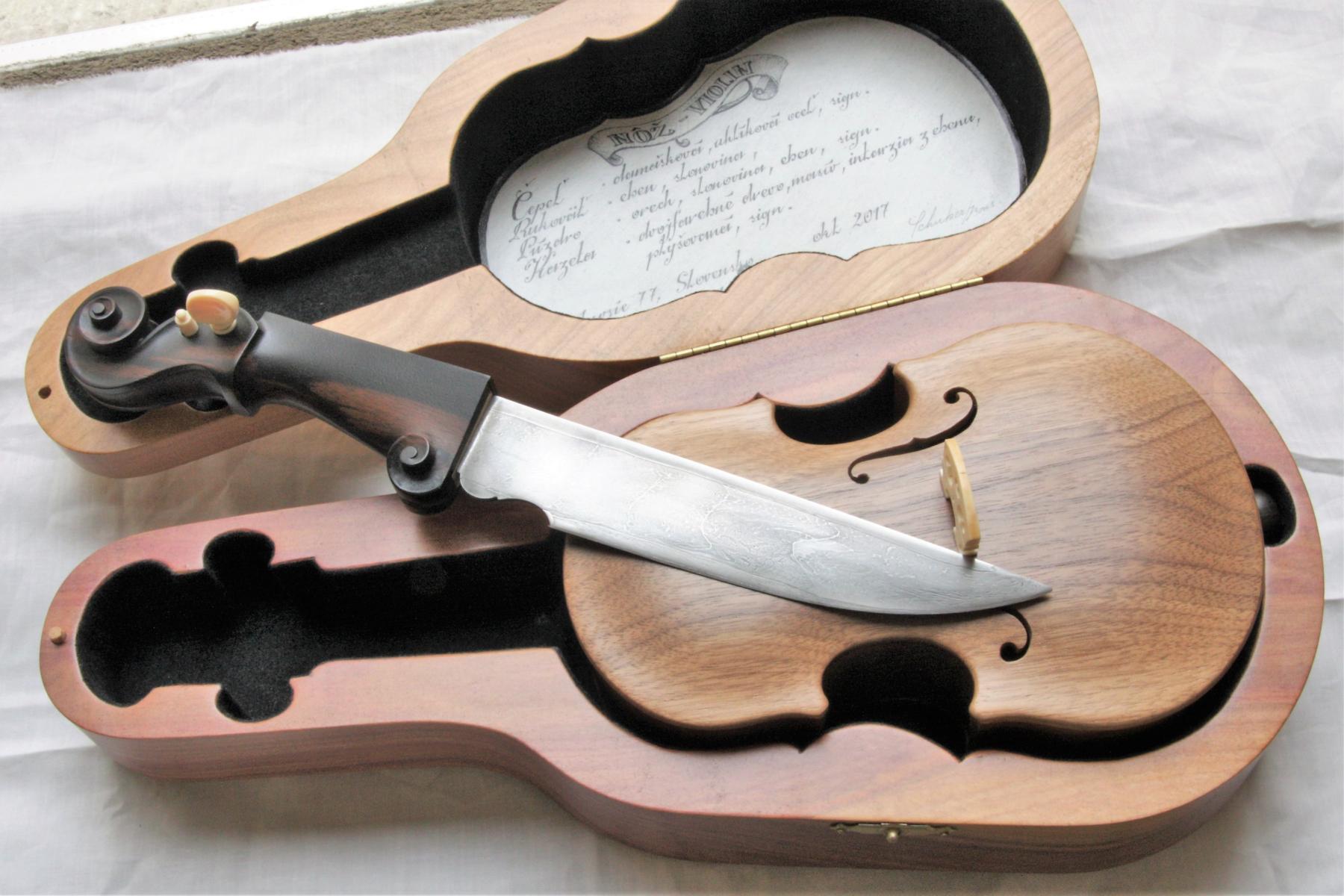
The Ave Maria by Boris Schubert, Poluvsie, Slovakia. The knife is disguised as the neck of a fiddle. The fiddle
has no strings. Blade material: carbon damascene steel, handle ebony and elephant bone,fiddle body from
cherry and apple tree, box from walnut and maple. Blade length 158 mm, overall length 295 mm.




‘Equippe do Chasse’ – a set of a hunting dagger and fork by Boris Schubert, Poluvsie, Slovakia. The handle
of the dagger contains a functional black powder / wheel lock gun (firing backwards as a finishing shot of mercy
for wounded animals). The handle of the fork contains a powder flask. Blade material and handle of the dagger
spring steel 14 260, fork material 14 260, handle carved stag.


Kolibrík (Hummingbird) by Albert Štefan, Slovakia. Carbon damascene steel blade by Yuri Verezhnikov.
Automatic (side opening) knife. Handle from steel and copper. Blade length 95 mm, overall length 195 mm,
folded length 112 mm.

Hunting dagger by Borecký, the blade of spring steel 14 260, handle ostrich bone and brass, blade length
350 mm, overall length 497 mm.

Jeleň (Deer) by Majan, Slovakia, blade material ATS 334, handle material thuja, sheet bovine bone. Blade
length 115 mm, overall length 235 mm.

Kolibrík (Hummingbird) by Richard Chromý, Slovakia. Blade material RWL 34, handle fossilized coral and
RWL34 steel with a citrine gem. Linerlock. Blade length 85 mm, overall length 200 mm, folded length 117 mm.
RWL34 steel with a citrine gem. Linerlock. Blade length 85 mm, overall length 200 mm, folded length 117 mm.

Hunting knives by Kováčik, Slovakia, blade damascene steel and Damasteel, handle birch and oriental wood,
blade length 130 mm and 140 mm, overall.

Knife by Wladyslaw Chulan, Ukraine, blade laminated steel – core K390 and carbon damascene steel,
handle iron wood and walrus teeth. Blade length 135 mm, overall length 267 mm.

Knives by Grigoriy Verezhnikov, Ukraine. Blades damascene carbon steel, handles from buffalo horn /
grenadille / ironwood. Blade lengths 165 / 120 /1353 mm, overall length 300 / 247 /254 mm.
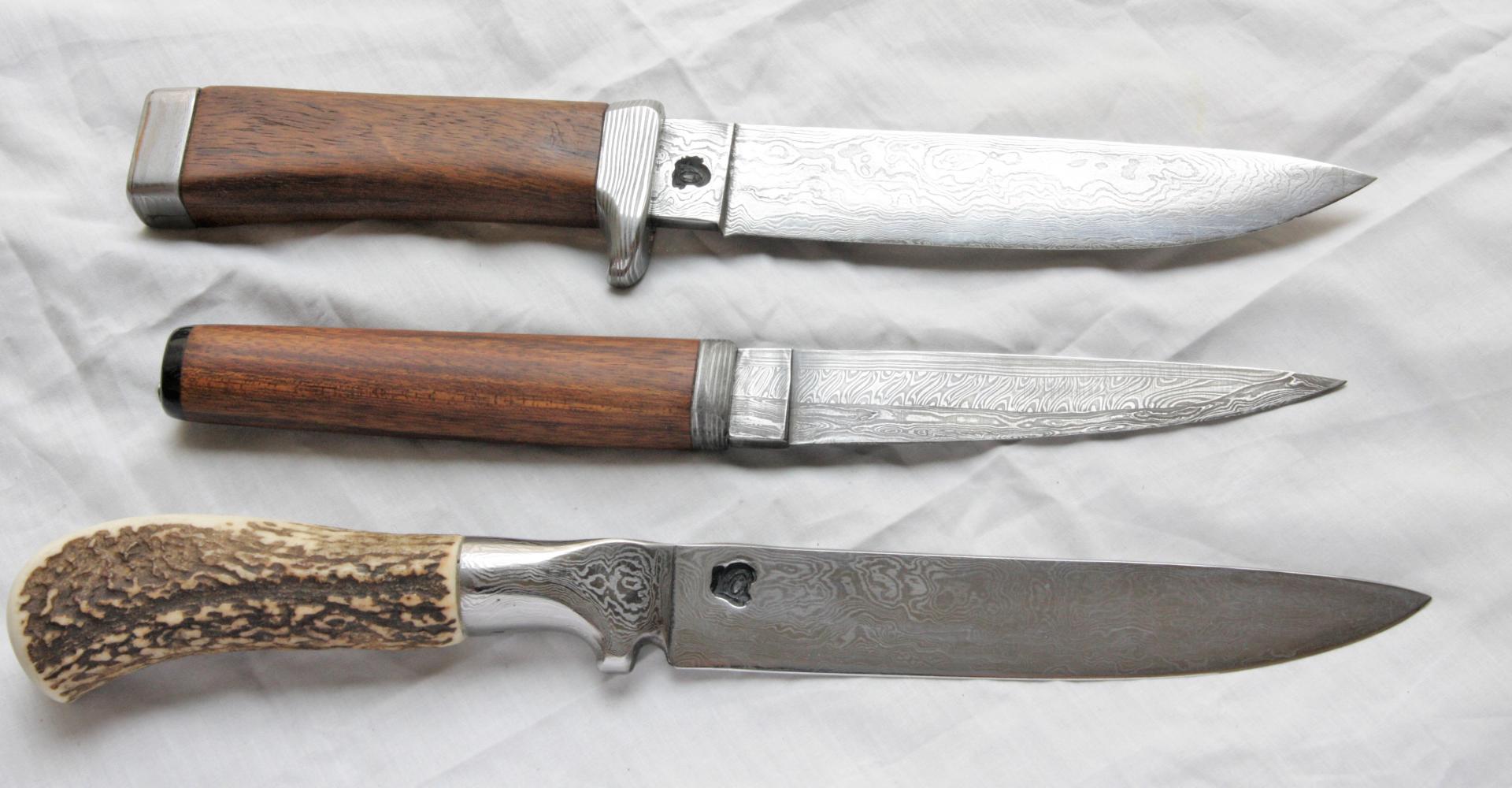
No names by Vincent Ostradický, Trnava, Slovakia. Blades from damascene carbon steel. Handles walnut /
walnut and buffalo horn / deer antler. Blade length 165 / 135 / 165 mm, overall length 290 / 260 / 290 mm.

Mistr Jan Hus (Magister Jan Hus, a famous clerical reformer of Czech origin) by Arpád Bojtoš, Lučenec,
Slovakia. Blade material Damasteel, handle steel and mammoth bone. Blade length 165 mm,
overall length 330 mm.

Viking and Los (Moose) by Martoš, Mladá Boleslav, Czech Republic. Blade material Tenax and AK5,
handle material fallow deer bone and cedar / antler and bankara wood. Blade length 251 /140 mm,
overall length 415 /262 mm.

No name by Ondřej Barták, blade material carbon steel 19 312, handle material leather and Corian.
Blade length 215 mm, overall length 355 mm.
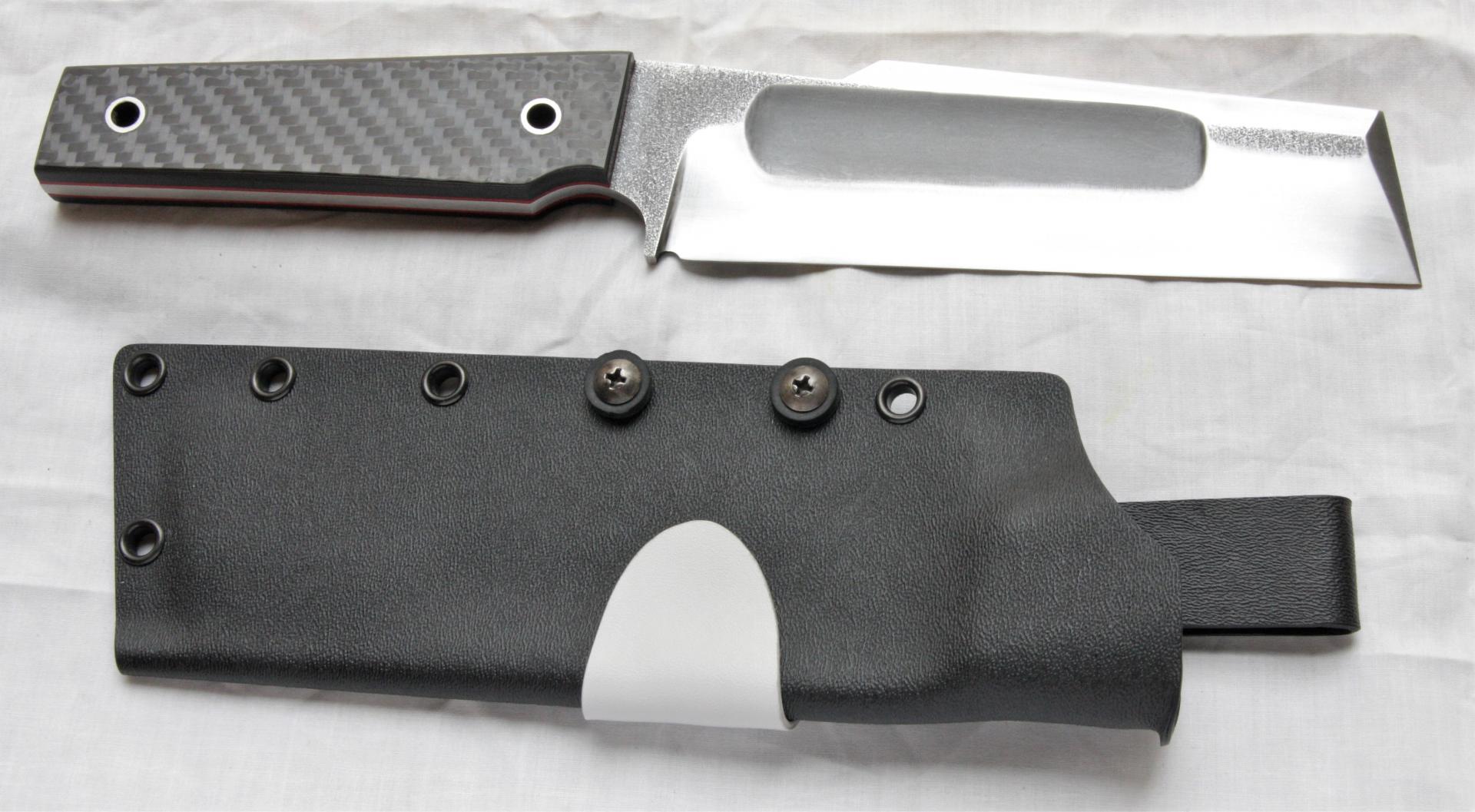
The ‘Technokrat’ by Ondřej Barták, blade material Sleipner steel, handle material carbon composite + G10.
Blade length 160 mm, overall length 283 mm.

‘Protektor’ and ‘Kolodach’ by Tomáš Trnečka, Czech Republic, blade material spring steel 14 260 both.
Handle material Padauk and Zebrano. Blade length 215 / 235 mm, overall length 345 / 380 mm.

No name by Karbous knives, J. Pacák, Czech Republic, blade material damascene carbon steel, handle
material Wenge. Handle locked on blade by a soldered wedge assembly typical for this knife maker.
Blade length 260 mm, overall length 410 mm.

No name by Miloš Kislinger, Dobronín, Czech Republic. Blade material stainless damascene steel, handle
material birch wood and plum wood. Blade length 140 mm, overall length 270 mm.

No name by Štefan Galovič, Slovakia. Blade material stainless damascene steel by Zladinox, handle
material grenadille and walnut. Blade length 95 / 120 mm, overall length 210 / 230 mm.

‘Flint’, by Adam Kornalski, Poland, blade material K720, handle material micarta, blade length 105 mm,
overall length 225 mm.

No names by Miloš Jun, Czech Republic. Blade material AK 6 (17 030), handle material plastic.
Blade length 130 / 105 mm, overall length 250/ 215 mm.

Pastierský nož – Sheppard’s knives by Milan Látka, Slovakia. A very distinct and traditional Slovakian knife.
The ornament varies from region to region. Handle is first grooved, then wrapped in parchment and finally the
grooves are filled by molten tin. Year after year Mr. Látka searches and researches historical sites and looks
for new ornaments. Here the blades are made from AK9 stainless steel, handles are walnut and tin.
Blade length 130 / 120 mm, overall length 240 / 220 mm.

No names by Janos Madaras, Hungary. Blade damascene carbon steel and 44C steel, handle bovine bone,
antler or bovine horn. Blade length 85 / 105 / 70 mm, overall length 220 (folded 135) / 220 / 150 mm.

No names by Ladislav Máté, Nové Zámky, Slovakia. Blade material nickel and carbon damascene steel
and 440C. Handle material Corian and antler and Wenge wood. Blade length 100 / 95 mm. Overall length
235 (folded 146) / 215 mm.

Sparta by Jozef Meszáros, Zemné, Slovakia. Blade material 695 N steel,
handle and sheath Corian, stand buffalo horn. Blade length 140 mm,
overall length 280 mm.

No names by Jozef Meszáros, Zemné, Slovakia. Made integrally from chrome vanadium tool steel – wrench. Blade length 95 / 95 mm, overall length 240 / 235 mm.

Ratatosker and Gothic daily by Roland Turčan, Slovakia. Blade material old files (carbon steel), handle
material cherry wood. Blade length 186 / 105 mm, overall length 302 / 205 mm.

No name by Okské nože (Oka knives). The knives were made by a local association of the knifemakers
in Pavlovo on the Oka river. Blade material carbon damascene steel or D2 steel, handle material hornbeam,
leather, birch. Blade length 170 / 125 / 135 mm, overall length 305 / 245 / 265 mm.

No name by Miroslav Pouzar, Czech Republic. Blade material wootz, handle Laburnum and reindeer antler.
Blade length 195 mm, overall length 355 mm.
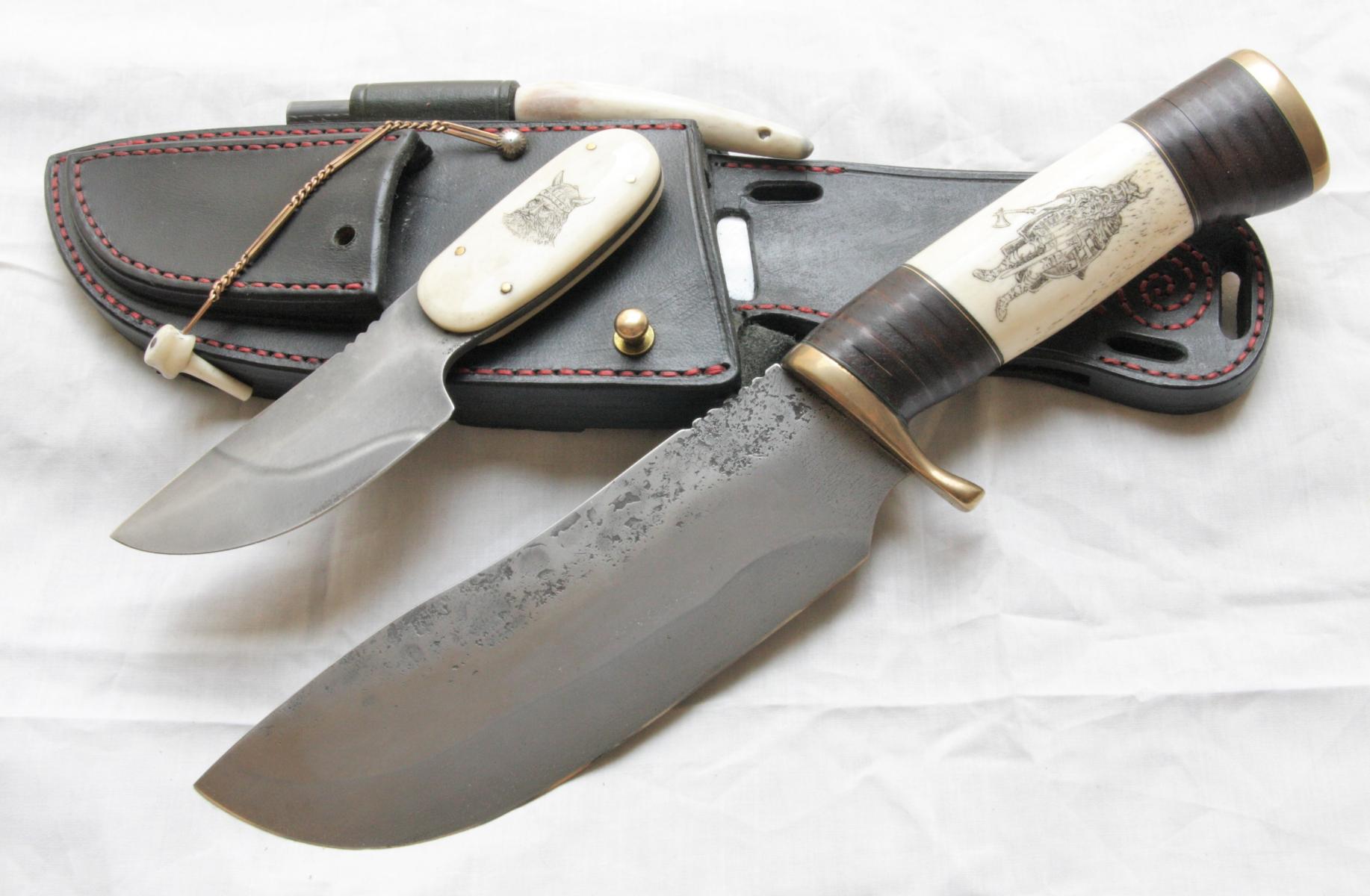
Viking - set of two knives in heavy leather sheath, a distinct trademark of the work of Miroslav Pouzar,
Czech Republic. Blade material AK7 steel, differentially hardened. Handle material reindeer stag and leather.
Blade length 165 / 87 mm, overall length 300 / 155 mm.
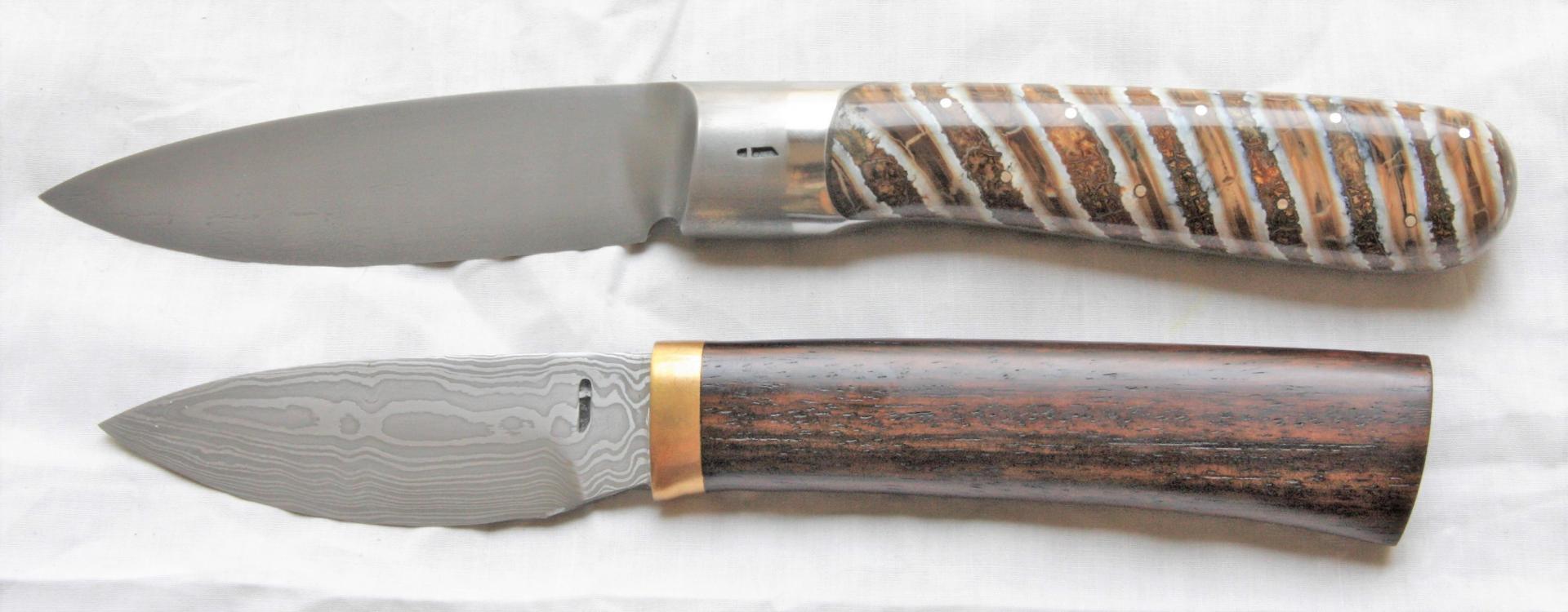
No names by Aleš Karban, Kroměříž, Czech Republic. Blade material stainless wootz and carbon damascene
steel made from 19 418 and 14 200 steels. Handle material mammoth teeth and palisander wood. Blade length
110 / 90 mm, overall length 237 / 205 mm.